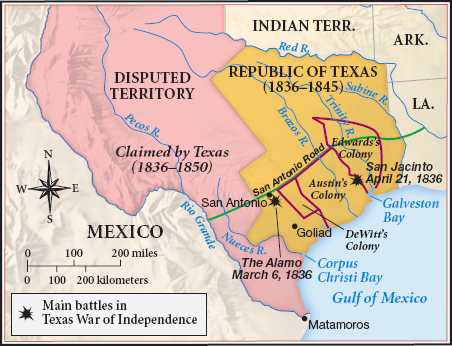America’s History: Printed Page 391
America: A Concise History: Printed Page 358
America’s History: Value Edition: Printed Page 346
The Settlement of Texas
After winning independence from Spain in 1821, the Mexican government pursued an activist settlement policy. To encourage migration to the refigured state of Coahuila y Tejas, it offered sizable land grants to its citizens and to American emigrants. Moses Austin, an American land speculator, settled smallholding farmers on his large grant, and his son, Stephen F. Austin, acquired even more land — some 180,000 acres — which he sold to newcomers. By 1835, about 27,000 white Americans and their 3,000 African American slaves were raising cotton and cattle in the well-watered plains and hills of eastern and central Texas. They far outnumbered the 3,000 Mexican residents, who lived primarily near the southwestern Texas towns of Goliad and San Antonio.

When Mexico in 1835 adopted a new constitution creating a stronger central government and dissolving state legislatures, the Americans split into two groups. The “war party,” led by Sam Houston and recent migrants from Georgia, demanded independence for Texas. Members of the “peace party,” led by Stephen Austin, negotiated with the central government in Mexico City for greater political autonomy. They believed Texas could flourish within a decentralized Mexican republic, a “federal” constitutional system favored by the Liberal Party in Mexico (and advocated in the United States by Jacksonian Democrats). Austin won significant concessions for the Texans, including an exemption from a law ending slavery, but in 1835 Mexico’s president, General Antonio López de Santa Anna, nullified them. Santa Anna wanted to impose national authority throughout Mexico. Fearing central control, the war party provoked a rebellion that most of the American settlers ultimately supported. On March 2, 1836, the American rebels proclaimed the independence of Texas and adopted a constitution legalizing slavery.
To put down the rebellion, President Santa Anna led an army that wiped out the Texan garrison defending the Alamo in San Antonio and then captured Goliad, executing about 350 prisoners of war (Map 12.2). Santa Anna thought that he had crushed the rebellion, but New Orleans and New York newspapers romanticized the deaths at the Alamo of folk heroes Davy Crockett and Jim Bowie. Drawing on anti-Catholic sentiment aroused by Irish immigration and the massacre at Goliad, they urged Americans to “Remember the Alamo” and depicted the Mexicans as tyrannical butchers in the service of the pope. American adventurers, lured by offers of land grants, flocked to Texas to join the rebel forces. Commanded by General Sam Houston, the Texans routed Santa Anna’s overconfident army in the Battle of San Jacinto in April 1836, winning de facto independence. The Mexican government refused to recognize the Texas Republic but, for the moment, did not seek to conquer it.
The Texans voted for annexation by the United States, but President Martin Van Buren refused to bring the issue before Congress. As a Texas diplomat reported, the cautious Van Buren and other party politicians feared that annexation would spark a war with Mexico and, beyond that, a “desperate death-struggle … between the North and the South [over the extension of slavery]; a struggle involving the probability of a dissolution of the Union.”
UNDERSTAND POINTS OF VIEW
Question
What issues divided the Mexican government and the Americans in Texas, and what proposals sought to resolve them?